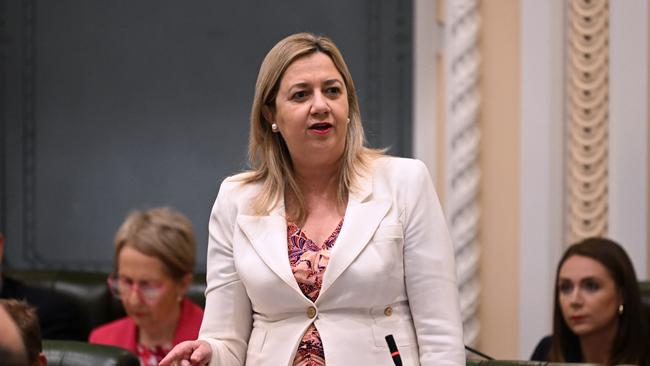Costly railway station build could scuttle $2.5bn Brisbane Olympics arena
The Queensland government is weighing whether to shift one of the glamour projects for the 2032 Games.

The Queensland government is exploring alternative sites for the showcase Brisbane Arena amid mounting concern the 2032 Olympics project can’t be built over a busy CBD railway hub for the $2.5bn pledged by Anthony Albanese.
Deputy Premier and State Development Minister Steven Miles has ordered his department to run the ruler over three other inner-city locations in recognition that the state will be on the hook for any cost blowout.
While Roma Street station was still preferred – erecting the 17,000-seat hall there promised to be “amazing” for the city, a senior government source said – the emerging complications meant site options that had initially been rejected were being dusted off.
The development came as Australian Olympics supremo John Coates warned that the federal government’s plan to slash cost-sharing with the states for major infrastructure projects from 80 per cent to 50 per cent would jeopardise the Games.
Soundings of potential contractors on Brisbane Arena have thrown up a range of potentially costly issues with Roma St station, which will become Brisbane’s “Grand Central” when the $6.3bn Cross River Rail subway opens in 2026 and passenger numbers triple inside a decade.
Concern has been raised that the challenging brief to sit the arena above the ground-level tracks could bust a budget that was capped at $2.5bn by the federal government when it split the cost of Games’ venues with Queensland earlier this year.

During the preliminary market soundings, the state government was warned that the commonwealth funding would be exhausted if there were overruns due to site access restrictions at Roma St, the presumed need to keep trains running through construction and the possibility that the elevated deck of the arena would be classed as a railway tunnel, requiring enhanced safety and engineering features.
The 2023-24 federal budget papers in May made it clear the Albanese government would not increase funding for the project, earmarked to host the glamour Olympic swimming competition in a drop-in pool.
A spokeswoman for federal Infrastructure Minister Catherine King told The Weekend Australian that the intergovernmental agreement contained “strong protections” including a joint business case, joint selection of the design and delivery partner, independent gateway review assurance and a commitment to demonstrate value for money.
“We are ensuring that every dollar has lasting benefits,” the spokeswoman said.
The confidential consultations with top-tier civil construction firms, specialist major project planners and financiers were conducted mid-year and have delivered the clearest picture yet of the job’s complexity within the footprint of Roma St station and railyard on the neglected western fringe of Brisbane’s CBD.
Executives from one construction contractor, speaking on condition of anonymity given the nondisclosure rules on market soundings, said the project was impossible to price because of the uncertainty around key procurement and scoping criteria.

If the station remained fully operational during the years-long build, site possession for the contractors could be severely curtailed – potentially limiting work to non-peak periods overnight or on weekends, the executives said. This would dramatically increase the cost.
The deck was another unknown quantity. The structure could ultimately be classified as a railway tunnel, depending on size and whether it was supported by pylons or a single engineering span. Designation as a tunnel meant expensive fire suppression systems, emergency exits and ventilation would be needed.
“We have to applaud the vision,” one of the executives said. “But what you need to work out is whether or not it is cost-efficient … and we’re none the wiser as to what the government has decided in that regard.”
A representative of another company that participated in the market soundings said: “You can build anything if you pay enough. There is no doubt that building above an operating railway station adds a substantial price premium to the project, the question is how much and how willing the client is to wear it.”
The senior Queensland government source said the alternative sites were a riverside 7ha factory lot acquired from Visy Industries in West End, opposite the CBD, and a parcel of state land in the top corner of the parklands reaching back from Roma St.
The third option was to demolish the Roma St headquarters of the Queensland police, facing the railway station. But this was problematic because the city watch-house would also have to go, and its proximity to the law courts precinct was considered essential by police.
The Visy glass factory site is, on paper, the easiest fix should the Roma St plan be scrapped. The land was acquired by the state government in 2022 for $165m and has been set aside for the international broadcast centre for the Olympics.
But The Weekend Australian understands that facility could be moved to the Brisbane Convention and Exhibition Centre, alongside the planned main media centre. The chief drawback of the Visy site was public access: the South Brisbane railway station, a Cross River Rail stop also serving West End, is 1.2km away while Milton station accessing Suncorp Stadium is nearer, but on the other side of Brisbane River.
In a statement, a spokesman for Mr Miles’ Department of State Development, Infrastructure, Local Government and Planning said the joint business case with the commonwealth to be finalised next year would “examine options associated with the delivery of the project and its siting, including technical, financial and economic impacts.”

Under the cost sharing deal for Olympic venues struck by the Prime Minister and Premier Annastacia Palaszczuk, Queensland will pay $2.7bn to rebuild the Gabba stadium while Canberra picks up the tab on Brisbane Arena. A new 20,000-seat stadium priced at $137m in the centrally-located RNA showgrounds, announced on Friday to accommodate international cricket and BBL fixtures as well as the AFL when the Gabba closes for redevelopment in 2025, lay outside the intergovernmental agreement and was proposed to be funded in a three-way split between the state, Brisbane City Council and the sporting codes.
Brisbane Arena has captured the city’s imagination since the idea to build above Roma St station and breathe life into a rundown section of the CBD was advanced by businessman Harvey Lister, of ASM Global, the biggest operator of stadiums and concert halls in the country.
“I think everyone agrees that it’s best long-term for the city,” the senior state government source said. “But as you get into more and more of the detail it gets more complicated … and that means it’s worth seeing if there are alternatives.”
Mr Lister is vying for the lucrative contract to manage Brisbane Arena, and has had the intellectual property right he asserts over the Roma St option recognised by the Queensland government. He declined to comment about the possibility that the site could be changed.








To join the conversation, please log in. Don't have an account? Register
Join the conversation, you are commenting as Logout